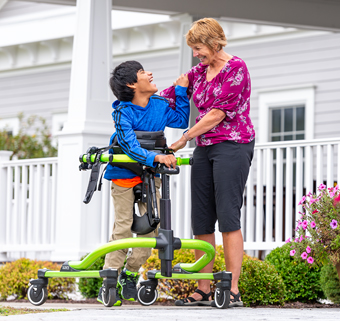
 Providing supported walking opportunities for people with multiple disabilities is a critical therapeutic intervention. For those diagnosed with cerebral palsy (CP), assessment of motor function and use of adaptive mobility and positioning devices helps determine their level on the Gross Motor Function Rating Scale (GMFCS). Individuals with cerebral palsy at GMFCS levels IV and V are more severely affected and are unable to walk independently; Their lives are largely sedentary. They require extensive adaptive support for all mobility and positioning, including gait trainers, standing devices, and wheelchairs. Progressive musculoskeletal impairments, such as contractures and windswept deformities, are common in this group, along with pain, decreased cardiovascular capacity, and limitations in function.
Providing supported walking opportunities for people with multiple disabilities is a critical therapeutic intervention. For those diagnosed with cerebral palsy (CP), assessment of motor function and use of adaptive mobility and positioning devices helps determine their level on the Gross Motor Function Rating Scale (GMFCS). Individuals with cerebral palsy at GMFCS levels IV and V are more severely affected and are unable to walk independently; Their lives are largely sedentary. They require extensive adaptive support for all mobility and positioning, including gait trainers, standing devices, and wheelchairs. Progressive musculoskeletal impairments, such as contractures and windswept deformities, are common in this group, along with pain, decreased cardiovascular capacity, and limitations in function.
For children in this group, specific opportunities to stand upright and actively use their muscles in functional tasks improve quality of life, benefit social interactions, and provide the positional changes necessary to reduce later secondary impairments.
Together with a previous systematic review that analyzed Results of Supported Stepping Devices in Children with Multiple Disabilitiesother recently published systematic scoping review The use of these devices in children, adolescents and adults with non-ambulatory cerebral palsy stands out. Some of the findings are noteworthy in a population and topic that is otherwise less researched.
Specifically, by broadening the scope of their search to include case studies, descriptive and gray literature, the researchers documented the successful use of supported stepping devices in more than 700 people with non-ambulatory cerebral palsy. Combined with reports from families and therapists of the benefits of gait training, this finding suggests that current provision and use of gait trainers in this population it remains best practice.
Compatible passing devices and ICF results
Using the ICF model and F-Words for childhood disability, this review reported the benefits of supported walking devices in the domains of body structure and function (fitness), activity (function), and participation (friendship) from nine months in forward. adulthood. Although some therapists prescribe gait trainers to improve mobility, the authors note that people with non-ambulatory cerebral palsy often use power wheelchairs for this functional mobility. Supported stepping devices are more appropriate for improving fitness and participation. Parents of children in GMFCS levels IV and V also tend to specify gait training goals focusing on physical activity, increasing independence, and improving participation in activities of daily living.
The authors also reported on the use of compatible passing devices by age, GMFCS level, and outcome. The findings were mixed, making it difficult to identify a clear trend. Therefore, gait trainer prescription and choice remains highly individualized taking into account funding, availability, transfer capabilities, environment, and postural support characteristics.
This scoping review provides a comprehensive overview of the literature related to supported stepping in people with non-ambulatory cerebral palsy. It is clear that there are still research questions to address in the future. Still, it remains true that providing people with cerebral palsy at GMFCS levels IV and V with opportunities to stand upright and bear weight improves quality of life through reduced sedentary behavior and the possibility of greater participation. .







